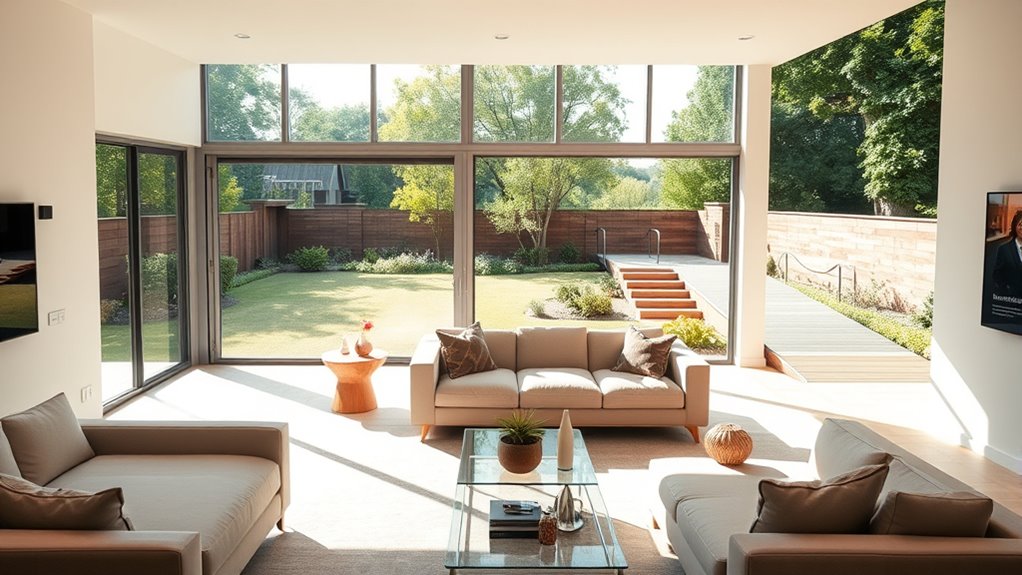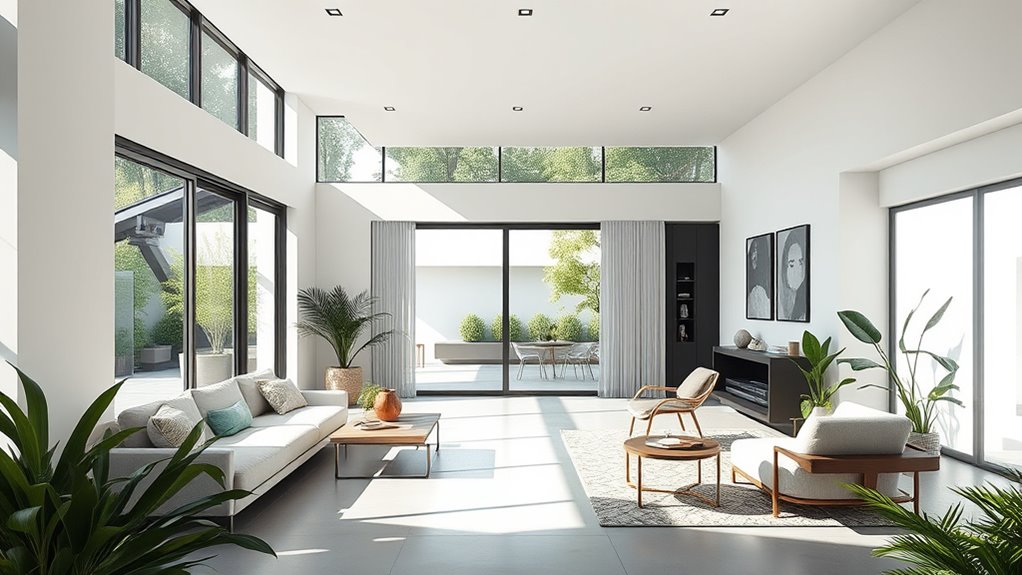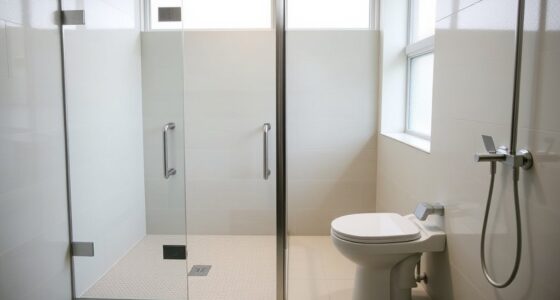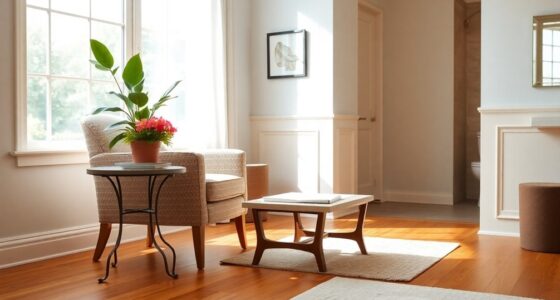To future-proof your home with ground-floor living, focus on accessible design features like wider doorways, no-step entrances, and open layouts that adapt to changing needs. Incorporate multifunctional spaces and adjustable elements, such as counters at different heights, to enhance versatility. Planning now saves costs and makes your home safer and more practical long-term. Keep exploring ways to create a flexible, resilient space that supports your evolving lifestyle.
Key Takeaways
- Incorporate universal design features like wider doorways and no-step entries for seamless accessibility.
- Design flexible, open floor plans that can adapt to changing needs over time.
- Include multifunctional spaces with built-in storage and fold-away furniture for space efficiency.
- Plan for adjustable features such as counters at different heights and grab bars for future modifications.
- Prioritize long-term usability by selecting durable, adaptable materials and thoughtful layout choices.

Planning for ground-floor living offers practical benefits, especially as you contemplate aging in place or improving accessibility. Designing your home with this in mind means creating spaces that are both functional and adaptable, guaranteeing comfort and convenience now and in the future. One of the key elements of future-proofing your home is incorporating multifunctional spaces. Instead of dedicating rooms to a single purpose, you can design areas that serve multiple functions, such as a home office that doubles as a guest bedroom or a living room with fold-away beds and storage. This approach maximizes space efficiency, making your home more versatile and easier to adjust as your needs change over time.
Accessible design is equally essential when planning for ground-floor living. It’s about making your home safe and easy to navigate for everyone, regardless of age or mobility level. This includes wider doorways and hallways that accommodate wheelchairs or walkers, low-threshold entryways to eliminate tripping hazards, and lever-style door handles that are easier to operate than traditional knobs. Installing no-step entrances and ensuring that essential areas—like the kitchen, bathroom, and laundry—are on the ground floor means you won’t have to worry about stairs or lifts down the line. These features not only improve daily convenience but also considerably enhance safety.
When you think about future-proofing, it’s important to reflect on how your home’s layout can evolve. Open floor plans are ideal because they allow for easy movement and flexibility in furniture placement. You might also want to plan for adjustable features, like counters at different heights or grab bars that can be added later without extensive renovations. Incorporating natural light and good ventilation further boosts accessibility, making spaces more inviting and easier to use for everyone. Additionally, body awareness and mindfulness practices can help you better understand and adapt to your changing needs over time, ensuring your home remains comfortable and supportive.
Smart design choices here aren’t just about comfort but also about extending the longevity of your home. By focusing on multifunctional spaces and accessible design, you create a living environment that adapts to your changing needs without the need for major renovations. This proactive approach saves you money and stress in the long run, giving you peace of mind knowing your home is prepared for whatever the future holds. Ultimately, thoughtful planning now guarantees your ground-floor living space remains practical, safe, and welcoming for years to come.
Frequently Asked Questions
How Can I Future-Proof My Home Against Changing Family Needs?
You can future-proof your home by incorporating smart technology and universal design features. Smart tech makes adapting to changing needs easier, allowing you to control lighting, security, and climate remotely. Universal design guarantees your space remains accessible for all family members, regardless of age or mobility. By combining these elements, you create a flexible, inclusive environment that adapts seamlessly as your family evolves.
What Are the Best Materials for Aging-In-Place Ground-Floor Renovations?
Think of your home as a sturdy ship sailing through changing tides. Opt for smart flooring that adapts seamlessly to mobility needs and durable finishes that withstand daily wear. These materials guarantee safety and longevity, making your ground-floor renovations future-proof. With the right choices, you create a space that remains comfortable and accessible, no matter how your family’s needs evolve over time.
How Do I Ensure Accessibility Without Sacrificing Style?
You can guarantee accessibility without sacrificing style by choosing smart design solutions that blend function with aesthetic appeal. Opt for sleek, low-threshold entryways, wide doorways, and lever-style hardware that look modern and elegant. Incorporate subtle ramps or incline transitions seamlessly into your flooring. Select fixtures and finishes that complement your decor, making sure your home remains beautiful while also being accessible and easy to navigate.
What Budget Considerations Are Involved in Ground-Floor Home Updates?
A thorough cost analysis reveals that ground-floor updates can fit various budgets. You should compare contractor quotes to balance quality with affordability. While investing in accessibility features may seem costly upfront, they often save money long-term by reducing future renovation needs. Prioritize essential updates first, then expand as your budget allows. Staying informed and consulting multiple contractors helps guarantee you make smart financial choices without sacrificing style.
Are There Eco-Friendly Options for Ground-Floor Home Modifications?
Yes, you can make eco-friendly ground-floor modifications by integrating solar panels to reduce energy use and lower bills. Consider rainwater harvesting systems to conserve water and support landscaping needs. These options are sustainable, cost-effective, and can be customized to fit your home’s layout. By choosing eco-friendly upgrades, you not only protect the environment but also future-proof your home for energy efficiency and resource conservation.
Conclusion
By planning thoughtfully now, you set your home up for future comfort and convenience. Consider your needs and adapt your space accordingly, because a stitch in time saves nine. Future-proofing your ground-floor living space guarantees you won’t be caught off guard down the road. So, take the time to make smart choices today—you’ll thank yourself later when everything falls into place seamlessly. It’s better to be safe than sorry when it comes to your home’s long-term livability.









